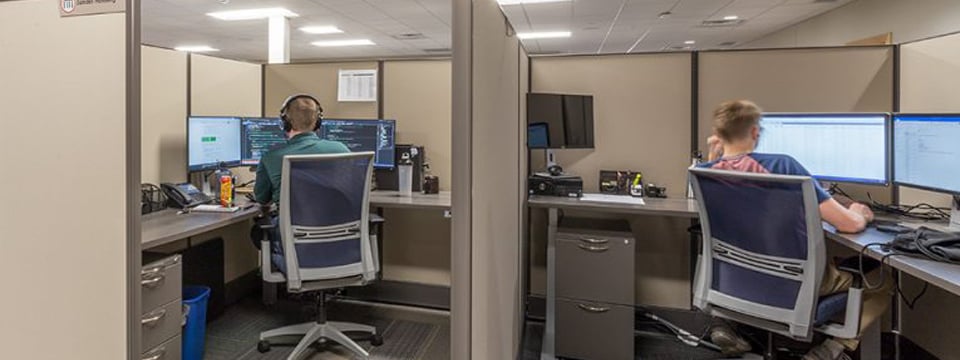The Changing Workplace Landscape

Preparing Your Facilities for the Next Phase
Things will be different as people return to work, whether it’s in an office, manufacturing facility, warehouse/distribution center, or myriad other workplaces. Everyone from employees to delivery drivers will need to be assured that you, as the building owner or manager, have taken the necessary precautions to ensure their health and safety. There’s a lot on your plate right now as you wade through re-opening protocols, state and federal orders, CDC guidelines, OSHA standards and regulations, and more. The design team at Widseth is here to help identify risks in your facilities and on your sites, and sort through the adjustments you can make to support the wellbeing of your employees, customers, and other building users.
SITE CIRCULATION AND PARKING
The increase in service providers, retailers, and others operating at “curb-side” calls for reconfiguring how vehicles navigate and park on-site. Multiple entrances, signage, and restriping accommodate efficient, logical traffic flow. For those who need to wait in their cars to be called into the building or to pick-up at curb-side, dedicated parking spaces should be located away from the flow yet positioned for easy integration back into the stream. Pedestrian access should be separate from vehicular circulation, clearly identified including signage or markers to support distancing, and, if the site allows, protected from the elements.
ENTRANCES AND INTERIOR CIRCULATION
Consolidating visitor entrances will help control external traffic, while a separate entrance for employees would minimize their exposure to outside visitors. Where protocols are being implemented to screen for symptoms of COVID-19 infection, a screening station or self-check kiosk may be needed at each entrance. Once inside, a one-way path through your building will facilitate distancing and mitigate cross-traffic.
RECEPTION
For this highly visible, high-traffic position, glass panels will limit contact while still facilitating communication. Removing furniture from waiting areas will support social distancing while limiting the surfaces that need to be sanitized.
OPEN OFFICE AREAS
While some businesses had built their teams around shared spaces that nurtured interpersonal collaboration, at least for the time being these employees are going to need spaces that support teamwork in a safer environment. Some offices have the floor space needed to rearrange workstations to achieve six feet of separation. In tighter spaces, new partitions, extensions added to existing partitions, or glass panels could be added between workstations as barriers between employees.
CONFERENCE ROOMS
Meetings in conference rooms may be passed over for video conferencing. If your employees’ work spaces did not already support connectivity, you may need to integrate high-speed network or internet access at employees’ workstations.
BREAK ROOMS
The shared coffee pot may be taking a hiatus, but catered boxed meals for employees will minimize the number of trips they need to make outside your facility during their shift. Short of closing break rooms and other common spaces, removing or rearranging some furniture will encourage distancing. Stations with hand sanitizer, masks, gloves, and wipes placed throughout common areas will encourage sanitizing these spaces and serve as a reminder to maintain good hygiene.
MANUFACTURING FLOORS
For those that have the space and flexibility, work areas can be set further apart, and production lines can be reconfigured. Operations that do not have this flexibility may need to reduce production or implement staggered schedules for the short term.
BUILDING MATERIALS, FINISHES, AND FIXTURES
Finishes and materials used in health care settings are crossing over to other types of facilities. For example, anti-microbial surfaces could replace wall coverings, flooring, and countertops in high-traffic, high-touch areas used by multiple people. Hands-free fixtures such as lights, faucets, soap and hand sanitizer dispensers, toilets, and doors could replace their manual counterparts.
RIGHT-SIZING
If your space is limited and you’ve exhausted options for mitigating the risks associated with working with others in close quarters, you may want to consider establishing satellite facilities or expanding your current space. If, on the other hand, your returning workforce or clientele is expected to decrease, you may need to downsize your facilities to remain viable and efficient.
AIR QUALITY
Improvements to a facility’s ventilation system, such as increasing ventilation rates and integrating additional outdoor air circulation, can support a healthier indoor environment. In systems where these improvements are not feasible, other steps may be taken including using MERV 13 or the highest efficiency filter your system can handle; changing filters frequently; keeping the system running when your facility is occupied; adding portable, free-standing HEPA filters; and maintaining a relative humidity level between 40% and 60%, either directly in a space or via air supply ducts. Caution should be taken, however, with wintertime humidification, which can lead to condensation, especially in older buildings.
PROMISING TRENDS
As researchers scramble to find ways to cope with or eliminate the SARS-CoV-2 virus, we continue to learn more about emerging trends or established technologies being used in new ways. One example is the use of electronic ionization to thwart viruses. While it may look promising, additional research is needed before we rely on this technology.
INSPIRING WORKPLACES
We may be living through unique times, but don’t lose sight of the importance of how your employees, clients, and building users experience your facility. We will all continue to need spaces that cultivate interaction, inspire creativity, motivate achievement, and foster collaboration. Our challenge is to design spaces that protect physical and emotional wellbeing.
Regardless of the combination of approaches you take within your facility, your employees and visitors are going to need time to adjust to new or modified spaces and to learn the new routines. One thing that has not changed in these last few months is that communication, education, and patience will go a long way toward encouraging compliance and making everyone feel comfortable with their new ways of working and interacting.
From listening, to brainstorming, to developing solutions, the Widseth design team is ready to help you navigate the new challenges we’re all facing. Let’s have a conversation about making sure your facilities are ready for the next phase. Start by contacting one of our architects near you:
Brainerd | Baxter
Mike Angland, AIA, LEED AP
218.316.3608
Mike.Angland@Widseth.com
Bemidji
Stephen Rose, AIA, NCARB
218.308.2615
Stephen.Rose@Widseth.com
Grand Forks | East Grand Forks
Brent Dammann, AIA
701.765.8005
Brent.Dammann@Widseth.com
Alexandria
Greg Bohl, AIA, CID, LEED AP
320.335.5009
Greg.Bohl@Widseth.com
Rochester | Mankato
Dana J. Hlebichuk
507.206.2135
Dana.Hlebichuk@Widseth.com

Search Archives
Categories
Posts by Topic
- Staff News (98)
- Architecture (66)
- Funding (61)
- Civil Engineering (53)
- Education (48)
- Architectural Design (38)
- Engineering (37)
- Land Surveying (32)
- Surveying (26)
- Environmental (22)
- Commercial (21)
- Interior Design (18)
- Streets & Highways (17)
- Utilities (17)
- Water Resources Engineering (14)
- Industrial (13)
- Community (11)
- Cultural (11)
- Landscape Architecture (11)
- Sports & Recreation (11)
- Government (10)
- Aerial Mapping (8)
- Mechanical Engineering (8)
- GIS (7)
- Electrical Engineering (6)
- Structural Engineering (6)
- Senior Living (5)
- Transportation Engineering (5)
- Bridges (3)
- Site Design (3)
- Transmission & Distribution (3)
- Healthcare (2)
- Planning (2)
- manufacturing (1)
Recent Posts
-
May 06, 2024



